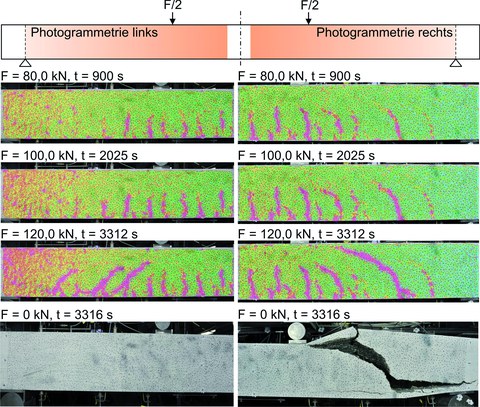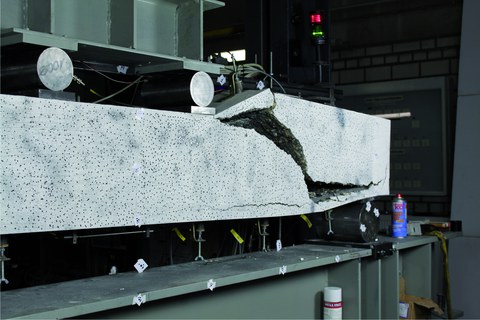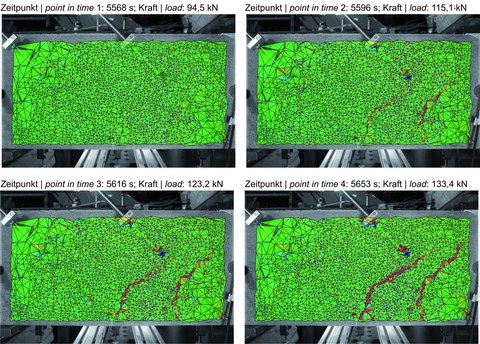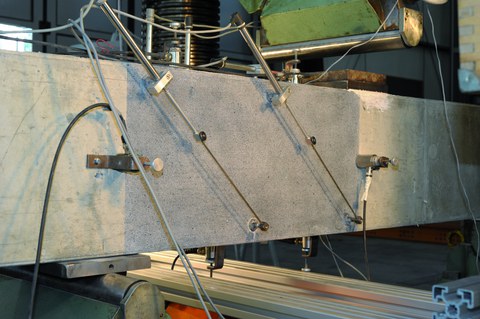Criteria for the determination of the ultimate load during a loading test
Table of contents
Project data
| Titel | Title Versuchsgrenzlastindikatoren bei Belastungsversuchen | Criteria for the determination of the ultimate load during an in-situ loading test Förderer | Funding Bundesinstitut für Bau-, Stadt- und Raumforschung im BBR Zeitraum | Period 10.2009 – 08.2011 (1. Phase) 12.2011 – 12.2013 (2. Phase) Leiter | Project manager Prof. Dr.-Ing. Dr.-Ing. E.h. Manfred Curbach Bearbeiter | Contributor Dipl.-Ing. Gregor Schacht Projektpartner | Project partners Prof. Dr.-Ing. Steffen Marx (Leibniz Universität Hannover) | Prof. Dr.-Ing. Guido Bolle (Hochschule Wismar) |
Short description
Sehr oft sind Bauingenieure damit beschäftigt, neue Bauwerke zu konstruieren. Doch seit einiger Zeit steigt der Bedarf an einer Weiter- bzw. Umnutzung bestehender Gebäude stetig an.Dabei erfordert der Umgang mit bestehenden Gebäuden eine grundsätzlich andere Herangehensweise als der Neubau. Das Bauwerk existiert bereits und Geometrie- und Bauteileigenschaften können nur noch geringfügig beeinflusst werden. Neben der baustofflichen und bauphysikalischen Untersuchung liegt das Hauptaugenmerk vor allem auf der Bewertung der Tragfähigkeit und Nutzungssicherheit der Bestandsgebäude. Diese Beurteilung ist besonders bei Bauwerken mit Baustoff- und Konstruktionsmängeln oder mit Schäden schwierig, bei denen sich die erforderliche Tragsicherheit rechnerisch nicht nachweisen lässt. Weitere Schwierigkeiten entstehen durch fehlende oder unvollständige Bestandspläne oder bei Unklarheiten über den statischen Lastabtrag. In solchen Fällen ist die experimentelle Tragsicherheitsbewertung eine sichere und wirtschaftliche Alternative zur Beurteilung der Tragsicherheit von Baukonstruktionen. In vielen Fällen können damit die Trageigenschaften wirklichkeitsnah eingeschätzt und Tragreserven erschlossen werden, so dass eine aufwändige Verstärkung oder gar ein Ersatzneubau nicht erforderlich sind. Die Versuchsziellast ergibt sich aus den Nutzungsanforderungen des Bauwerkes und ist die Last, die im Versuch nachgewiesen werden soll. Die Festlegung sinnvoller Abbruchkriterien wie z. B. der sogenannten Versuchsgrenzlast kann dagegen weitaus schwieriger sein. So kommt es immer wieder vor, dass vorhandene Tragreserven bei Tragwerken mit geringer Duktilität aufgrund fehlender Bewertungskriterien nur bedingt berücksichtigt werden können. Deshalb wird in diesem Forschungsvorhaben daran gearbeitet, auch für diese Art von Tragwerken Indikatoren zu entwickeln, die eine zuverlässigere Bestimmung der Versuchsgrenzlast ermöglichen. Dazu werden neben der herkömmlichen Messtechnik vor allem 2D- oder 3D-Messverfahren wie die Photogrammetrie und die Schallemissionsanalyse verwendet. Durch die Kombination dieser Messverfahren soll eine wesentliche Verbesserung der Informationsqualität während eines Belastungsversuches erreicht werden. Ziel ist es, objektive Kriterien für die Bestimmung der Versuchsgrenzlast definieren zu können. Dadurch soll gewährleistet werden, dass beginnendes nichtlineares Strukturverhalten auf sehr geringem Lastniveau unmittelbar während des Versuches festgestellt und damit die Versuchsgrenzlast schädigungsfrei ermittelt werden kann.
Report in the yearbook 2013
Pictures which Increase the Safety

Photogrammetric evaluation of the crack development.
Depending on the type of loading and the construction, reinforced concrete elements can fail in different ways. The goal of every design and detailing is to ensure that elements somehow indicate impending failure so that there is no danger for life. In today’s building codes this guaranteed announcement of elements and structures is given through minimum reinforcement requirements, but older constructions often have deficits concerning this point. A big problem e.g. are elements with too small or no reinforcement for primary shear action, which is able to bridge and hold together the inclined cracks in case of shear crack development.
Nevertheless, to be able to investigate these constructions by load testing and to proof that their load bearing capacity is sufficiently high, this research project analyzes the processes and mechanisms of shear failure in detail. Through a combination of photogrammetry, acoustic emission and common measuring techniques, the information about the condition of the structure under test load shall be improved and the cracking process in time and space shall be better resolved. The analysis of the crack development is the main measuring goal for shear failure because global deformation information, such as deflections, cannot be used for the safe detection of beginning shear failure.
In experimental investigations of beams without and with small shear reinforcement it could be proven that especially photogrammetry is a very effective and powerful measuring technique. To be able to detect and analyze crack developments with the photogrammetry online during the experiment, i.e. to make smallest structural changes visible, the beams were artificially textured and a specific software was developed. The tracking of the deformation of these points in a series of pictures and their evaluation by coloring cracked areas at the PC allowed the early detection of beginning damage processes. Thus, the possible loading could be determined for future use. Connecting the results of the other measuring techniques with the photogrammetric evaluation led to a considerably improved resolution of the damage and failure process in time and space and a deeper understanding of the mechanisms that cause failure.
Report in the yearbook 2012
Seeing, Hearing and Feeling Shear Failure Better

Brittle failure of a reinforced concrete beam under shear
Older steel reinforced or prestressed concrete structures often have too less reinforcement to fullfil the theoretical requirements of the actual standards. But, because we can’t demolish all of such constructions and replace them by new ones, civil engineers are asked to find and use hidden reserves which have not been taken into account in the calculation.
A real efficient method to identify these load bearing reserves is the experimental investigation of structure. Thereby the investigated structure is self-locking put under hydraulic pressure and the reactions are measured. Because an irreversible damage of the structures has to be avoided, the beginning of the damaging process securely has to be detected. By now, this is not securely possible for all known failure modes of reinforced concrete structures, because the usually used global deformation measurements don’t show clear signs of a prior failure in some cases, e.g. shear failure near an abutment.
Relatively good-natured are bending stresses, because big deformations and/or extensive cracking announce an upcoming failure clearly. On the other hand there are non-ductile failure types, like the compression failure of over-reinforced cross sections or – and this is often even more critical – a failure in case of a not sufficient shear resistance, which are very critical.
In this research project we therefore aim to improve the information about the structural condition in real-time with the help of modern measuring techniques. The parallel applied measuring techniques of the photogrammetry, the acoustic emission analysis and the partly deformation measurements with inclination sensors intensify the human senses seeing, hearing and feeling and therewith allow an early detection of the developing damage process in case of a probable shear failure of reinforced concrete beams with shear reinforcement. The combination of the different measuring techniques improves the quality of the results significantly and enables the exact description of the condition of the structure.
In first laboratory tests the online-ability of the photogrammetric evaluation was successfully tested. In the next steps this technique shall be used for large experiments.
Report in the yearbook 2011
Advance Notice of Shear Failure

Visualization of the crack pattern with photogrammetry
For the experimental investigation of existing reinforced concrete structures it is crucial to analyse and assess the load bearing behaviour simultaneously during the loading test. Only the on-line evaluation ensures the detection of an impending failure at an early stage or to avoid an inadmissible damage of the structure. In contrast to bending failure this is yet not always securely possible for low-ductile types of failure, like the shear failure of reinforced concrete elements without web reinforcement, because of their little advanced notice of developing failure.
Aim of the research project is the detailed investigation of the load bearing behaviour of reinforced concrete elements without web reinforcement and the development of so called ultimate test load indicators, which allow a reliable on-line assessment of the actual condition of the structure and therefore prevent any undesired and inadmissible damage.
For this purpose, additional to common measuring equipment, especially 2D and 3D measuring technologies like photogrammetry and acoustic emission are used. By combining the different measuring technologies it is aimed to improve the quality of structural information during an experimental investigation and to obtain objective criteria for the experimental maximum load.
In the experiments of the shear bearing behaviour a certain advanced notice of the failure was detectable with the used measuring techniques. The figure on the left page shows the direct time based comparison of all measuring techniques. It can be seen that the acoustic emission and the photogrammetry were able to indicate the developing shear crack and thereby a critical condition of the beam can be detected sufficiently early.
In the following steps the theoretical and experimental findings are to be further elaborated to indicators, which are then tested and verified in subsequent laboratory and in-situ experiments.
Report in the yearbook 2010
Advance Notice of Shear Failure

Measurement on the test specimen
For the most part civil engineers have to deal with the construction of new buildings. But since a couple of years the need of a further or different use of existing structures increases continuously.
Thereby the handling and the assessment of existing structures requires a totally different approach than new constructions. The structure already exists and geometry and material characteristics are defined and can only marginally be influenced. Therefore a main focus is – in addition to material and physical examinations – put on the assessment of the load bearing capacity and the serviceability. This evaluation is especially difficult for structures with material or construction deficiencies, damages or similar problems, which make it difficult to verify an adequate structural safety analytically. Additional difficulties are caused by missing or incomplete as-built drawings and documents or uncertainties in terms of force transfer through the structure. For these cases the experimental evaluation is an alternative method for a safe and economic assessment of the structural safety of existing structures. Therewith the loading carrying behaviour can be realistically evaluated and hidden load bearing capacity reserves can be determined in many cases and a costly reinforcement or even reconstruction can be avoided.
The target test load results according to the requirements of use and is the load that has to be proven by the loading test. The definition of practical abort criteria like the so called ultimate test load can therefore be more difficult. For this reason, it often happens, that the existing load bearing reserves of structures with less ductility can only partly be used because of missing assessment criteria.
Therefore it is the aim of this research project to determine indicators, which allow a reliable definition of the ultimate test load for these types of structures. For this purpose, additional to common measuring equipment especially 2D and 3D measuring technologies like photogrammetry and acoustic emission are used. By combining the different measuring technologies it is aimed to improve the quality of structural information during an experimental investigation and to obtain objective criteria for the experimental maximum load. Thus the detection of a beginning non-linear structural behaviour at an already very low level shall be guaranteed and the definition of the ultimate test load is possible without causing damage to the structure.
